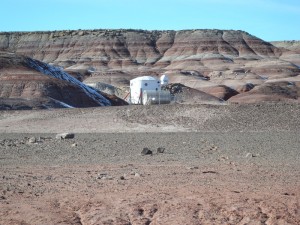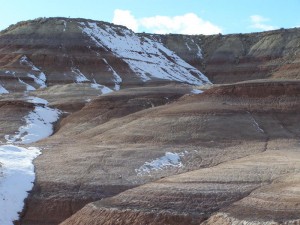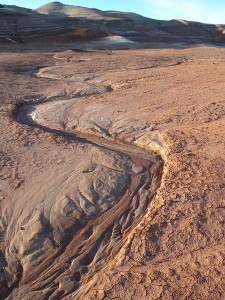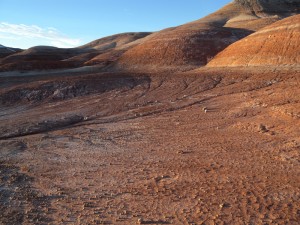I really cannot exaggerate the beauty of the surroundings we find ourselves in at the Mars Desert Research Station. I grew up in southeastern Utah, so I might have expected to be inured to it—but really, it is just phenomenal. During yesterday’s EVAs, we got to see a lot of the stunning sights, and local geology, first-hand.
The Hab sits in the Brushy Basin member of the Morrison Formation, from the Jurassic period. These rocks were formed from freshwater lake sediments, with occasional volcanic ash deposits. The colors in the resulting claystone, mudstone, and siltstone are just phenomenal—bands of rich red, cream, brown, yellow, and purple. Atop these bands lies pieces of the Dakota sandstone that you can just make out in the background hills in this picture (click to see larger version). Yes, that’s snow! We’ve been enjoying simply beautiful weather since we arrived: sunny, clear skies and temperatures in the upper 30’s to low 40’s during the day. The snow fell during the previous crew’s final days and remains on the north-facing slopes. More snow is forecast for tomorrow; I’m hoping it skips us, so that the rocks and formations remain in clear, brilliant view. Yesterday during EVA #2, we walked north from the Hab across very slippery red mud and clay. Daytime temperatures do get high enough to melt snow on the south-facing slopes, and it runs off the hills, both soaks into the soil and depositing the fine-grained mud layers we were walking on. We left giant bootprints in several areas, and skid marks where it was slipperier than it appeared. We also crossed some cracked mud areas where water had evaporated, and the “popcorn” surface created by smectite (a clay) when it dries out. At left is one of the meandering channels flowing from the foot of the hills out over the muddy plain. As the sun dropped in the sky, the shadows from every rock and pebble were highlighted, giving dramatic relief to the surface and emphasizing the angularity of the rocks. These rocks mostly come from the overlying Dakota sandstone, which is coarser-grained and more resistant to weathering than the soft mudstone and claystone of the Morrison Formation. The Dakota sandstone is the remnant of an inland ocean, so it arises from a very different water environment than the Morrison Formation does. We are told that this layer contains regions with coal, petrified wood, and bivalve fossils. We haven’t found these yet, but we hope to explore the Dakota more extensively in a future EVA! To the left is a picture of an outcrop of Dakota from EVA #1 (which explored the region around Phobos Peak). Its greater resistance to weathering is evident in how this large block rests on an undercut layer of Morrison supporting it. And finally, we used the rock hammer to collect a sample of a layered piece of Dakota that may possibly have some endoliths growing on it. We also reached a large chunk of Dakota sandstone at the base of Olympus Mons during EVA #2 (see right). Although at an entirely different location, it shows the same differential erosion. That’s Crew Astronomer Mike posing in front of the rock in his EVA suit, with our crew 89 patch on his arm. Thanks go to all of our crew for their great EVA work yesterday and the photos and stories they brought back! We’ll have another geology-oriented EVA coming up soon.Mission: January 23 to February 6, 2010





